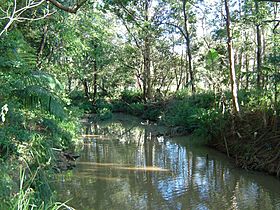Bulimba Creek facts for kids
Quick facts for kids Bulimba Creek |
|
|---|---|

Bulimba Creek at Mansfield, 2014
|
|
|
Location of the Bulimba Creek mouth in Queensland
|
|
| Other name(s) | Doboy Creek, Doughboy Creek |
| Country | Australia |
| State | Queensland |
| Region | South East Queenseland |
| City | Brisbane |
| Physical characteristics | |
| Main source | Mount Gravatt via Bulimba Creek West Kuraby 27°32′48″S 153°4′20″E / 27.54667°S 153.07222°E |
| 2nd source | Bulimba Creek East Runcorn 27°36′30″S 153°3′50″E / 27.60833°S 153.06389°E |
| River mouth | confluence with the Brisbane River East Brisbane 0 m (0 ft) 27°25′46″S 153°7′46″E / 27.42944°S 153.12944°E |
| Basin features | |
| River system | Brisbane River |
| Basin size | 122 km2 (47 sq mi) |
Bulimba Creek, also called Doboy Creek or Doughboy Creek, is a stream in Brisbane, Queensland, Australia. It flows into the Brisbane River. The name Bulimba comes from an Aboriginal word, Boolimbah, which means 'a place of the magpie-lark'.
Contents
Where Does Bulimba Creek Flow?
The Bulimba Creek catchment area starts in the suburbs of Sunnybank, Runcorn, and Kuraby. A catchment is an area of land where all the water drains into one main river or creek.
The creek then flows north through suburbs like Mansfield, Carindale, and Lytton. Finally, it joins the Brisbane River near Lytton.
What Are Its Branches and Wetlands?
Bulimba Creek has six smaller streams that flow into it. These are Mimosa Creek, Spring Creek, Salvin Creek, Phillips Creek, Tingalpa Creek, and Lindum Creek.
There are also important wetland areas along the creek. These include Runcorn Wetlands, Numgubbah, Tingalpa, Doboy, and Lindum Wetlands. Wetlands are special areas where the land is covered by water, either all the time or just part of the year. They are very important for wildlife.
How Has the Creek Changed Over Time?
Today, the creek is mostly surrounded by city buildings and factories. In the past, the land around the creek was cleared for farming. Over time, some of the plants along the creek have started to grow back.
The area around the creek has many nature reserves. These are protected areas like Karawatha Forest, Toohey Forest Conservation Park, and Whites Hill. These reserves help protect the natural environment.
What Animals and Plants Live Here?
Bulimba Creek is home to many different animals and plants. Some are native to Australia, while others have been introduced.
Introduced Species
Sometimes, new species are brought into an area. These can cause problems for the native plants and animals.
- An invasive fish called tilapia lives in the creek.
- A waterway weed called salvinia was first found here in 1953. It can grow very fast and cover the water.
Threatened Species
Many animals and plants in the nature reserves are considered threatened. This means they are at risk of disappearing.
- In Whites Hill, you might find the powerful owl, grey-headed flying fox, and grey goshawk.
- Rare plants include Shirley's tuckeroo and Macadamia integrifolia.
Karawatha Forest is a special reserve with many different species. It has five types of glider possums! To help animals cross busy roads safely, special bridges and tunnels have been built. There are also rope ladders and fences to guide animals away from danger.
A Look at Bulimba Creek's History
Who Lived Here First?
For thousands of years, the Indigenous Yuggera and Turrbal people lived in or traveled through the Bulimba Creek area. They called a place on the creek boolimbah, which meant 'a place of the magpie-lark'. This name is thought to refer to what is now known as Whites Hill. The name Bulimba Creek was first officially used in 1888.

Early Uses of the Creek
In the late 1860s, a large paddle steamer called the Walrus was used on the creek. It was Australia's first floating distillery, which means it made alcohol. It also had a steam-powered sugar mill on board. The Walrus traveled along Bulimba Creek and the Brisbane River.
Changes to the Creek Mouth
In 1889, people decided to make the Brisbane River straighter and deeper. This meant changing where some creeks joined the river. The mouth of Doughboy Creek (now Bulimba Creek) was moved to its current spot. This was done by building a long wall to guide the water.
Pollution Incident
In 2008, there was an oil spill near Bulimba Creek in Carindale. This caused pollution in the valley. A lot of contaminated soil had to be removed from the area to clean it up.
Helping Bulimba Creek: The B4C
The Bulimba Creek Catchment Coordinating Committee, also known as the B4C, is a group of volunteers. They are part of the Landcare Group. They work to protect and restore the waterways, bushlands, and wetlands around Bulimba Creek.
The B4C was formed in 1997. They were the first urban group in Queensland to win a State Landcare award in 2000. In 2005, they won the important Thiess National Riverprize.
What Has the B4C Achieved?
The B4C has had many successes in protecting the environment.
- They helped save the Weekes Road and Oates Hill Bushlands from being developed.
- They also saved the Wishart Bushlands from development.
- They worked on a big project to restore the Bulimba Creek Oxbow, a large wetland area.
The B4C also has its own foundation called the "Bulimba Creek Environment Fund." This fund gives small grants to people in the community who want to get involved in environmental projects. The B4C has a catchment center and a community nursery. They are working to create a sustainability center with their partner, Powerlink. This center will show how to live in a way that helps the environment.


